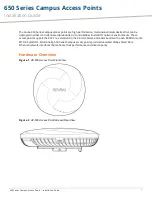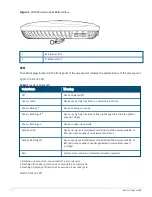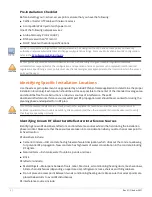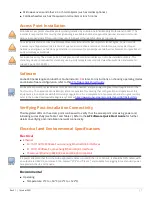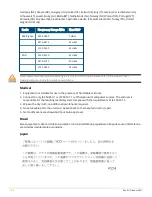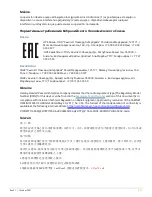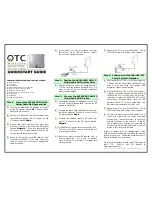
6
|
Rev 01|October 2021
Pre-Installation Checklist
Before installing your <series> access points, ensure that you have the following:
n
Cat5E or better UTP cable with network access
n
A compatible PoE injector with power cord
One of the following network services:
n
Aruba Discovery Protocol (ADP)
n
DNS server with an “A” record
n
DHCP Server with vendor specific options
Aruba, in compliance with governmental requirements, has designed the 650 Series access points so that only
authorized network administrators can change configuration settings. For more information about AP configuration,
refer to the
.
Access points are radio transmission devices and as such are subject to governmental regulation. Network
administrators responsible for the configuration and operation of access points must comply with local broadcast
regulations. Specifically, access points must use channel assignments appropriate to the location in which the access
point will be used.
Identifying Specific Installation Locations
Use the access point placement map generated by Aruba RF Plan software application to determine the proper
installation location(s). Each location should be as close as possible to the center of the intended coverage area
and should be free from obstructions or obvious sources of interference. These RF
absorbers/reflectors/interference sources will impact RF propagation and should be accounted for during the
planning phase and adjusted for in RF plan.
Use of this equipment adjacent to or stacked with other equipment should be avoided because it could result in
improper operation. If such use is necessary, this equipment and the other equipment should be observed to verify
that they are operating normally.
Identifying Known RF Absorbers/Reflectors/Interference Sources
Identifying known RF absorbers, reflectors, and interference sources while in the field during the installation
phase is critical. Make sure that these sources are taken into consideration when you attach an access point to
its fixed location.
RF absorbers include:
n
Cement/concrete—Old concrete has high levels of water dissipation, which dries out the concrete, allowing
for potential RF propagation. New concrete has high levels of water concentration in the concrete, blocking
RF signals.
n
Natural Items—Fish tanks, water fountains, ponds, and trees
n
Brick
RF reflectors include:
n
Metal Objects—Metal pans between floors, rebar, fire doors, air conditioning/heating ducts, mesh windows,
blinds, chain link fences (depending on aperture size), refrigerators, racks, shelves, and filing cabinets.
n
Do not place an access point between two air conditioning/heating ducts. Make sure that access points are
placed below ducts to avoid RF disturbances.
RF interference sources include:

